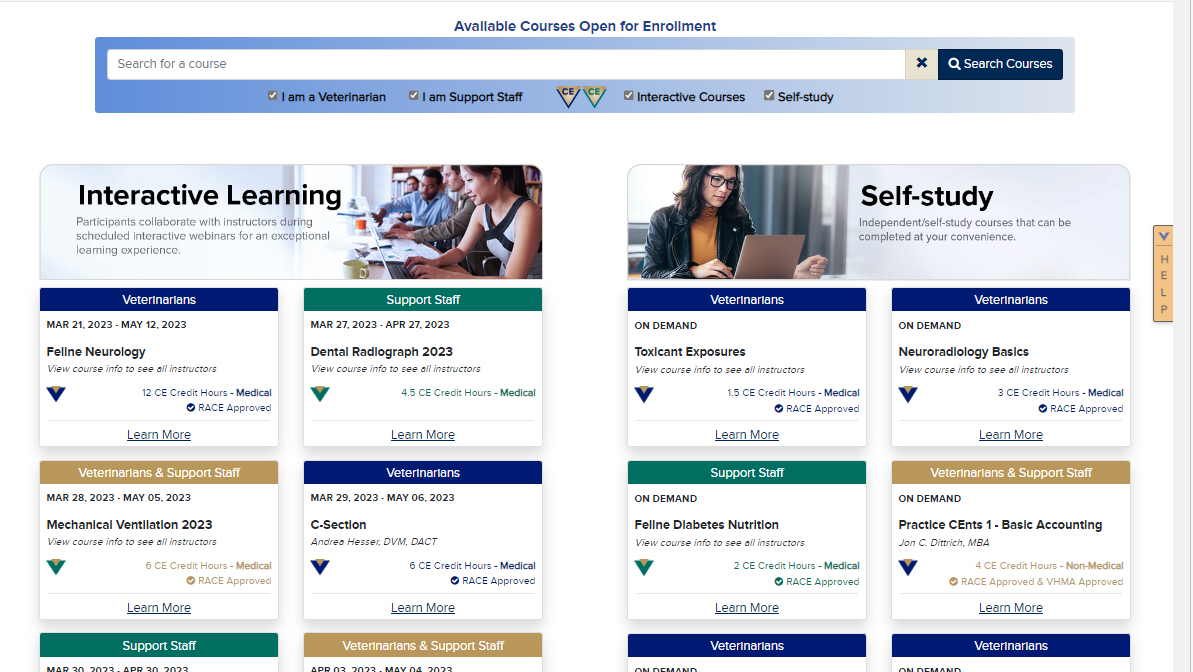In this document, we will review the information needed to create a course information page.
Course Information Page
Your course facilitator creates a course information page based on your provided information. This information is used for all promotional materials, including the course catalog listing and CE flyers.
Information on this page is essential for the prospective participant to see if the course is appropriate to their experience level and will meet their learning needs. It must contain an outline of your course topics, shown in the order in which they will be presented during the Real-Time Sessions, and should reflect all content covered during the course. So, you'll need to design the course to include the content outlined in the course description.
The course information page is submitted to:
- AAVSB's RACE committee for approval of CE credits,
- any state or province that requires special permissions, and
- the VHMA if the course is designed for practice managers seeking credit toward CVPM credentials.
Information you need to provide for your course facilitator to complete the course information page:
- Your name and credentials, e.g., Joe Bartges, DVM, Ph.D., DACVIM, DACVN
- Real Time Session dates. Please consult with your course facilitator to determine the dates/times for the Real Time Session dates. Together you will decide which dates/times are best for your schedule and the VIN/VSPN CE course schedule.
The course area typically opens a week before the first scheduled Real Time Session and closes 10 days after the last Real Time Session. As the instructor, you are expected to monitor the course message boards once daily while the course is open.
- Session format. The course will be presented in an audio format.
- With the audio format, you will submit a PowerPoint presentation and poll questions. During the Real Time Sessions, you will progress through your presentation slideshow and broadcast your lecture to the participants. The session moderators will send polls; questions are usually answered using audio.
- Level. The level indicates the difficulty of the course material. The levels are basic, intermediate, advanced, or specialty. Definitions for these terms are provided in the Course Catalog.
- Prerequisites. Describe any prerequisite experience, knowledge, and courses the participant will need to get the most out of the course.
- Intended Audience. Who is this course intended for? You can say veterinarians, veterinary technicians, or both. But with some courses, you will want to indicate the technical level of the participants - front office, veterinary assistant, veterinary technician, practice manager, veterinarian, general practitioner, etc.
Confer with your course facilitator to determine the accreditation for the course - RACE (veterinarian/veterinary technician), VHMA, specific state accreditation boards, etc.
- Course Description. This should be detailed enough to give prospective CE participants an excellent general sense of what the course will cover and if the material level is appropriate for them. Try to give this paragraph a little marketing flair if you can. Maybe include a promotional line or paragraph at the beginning of your course description.
VSPN courses may be geared toward any of the veterinary support staff personnel. However, each course should indicate the specific type of staff members expected to benefit from the course.
-
Course Objectives. RACE requires the inclusion of the following wording "Upon completion of this course, you should be able to:..." within the description, followed by a bulleted list of learning objectives for the course. Try to provide 1-3 learning objectives per Real Time Session.
To help you focus the wording of this section to the participant's level, a list of action verbs is provided in the following document: Action Verbs.
- Textbook(s) and Ancillary Materials: If, in addition to the library materials you provide, you require or recommend reading material, such as a manual, please include that information with the course description. Please indicate whether the materials are required or merely recommended. Visit the VIN Store to see which textbooks VIN can provide at discounted rates,
- About the Instructor. Please provide a 3-4 sentence paragraph about yourself that highlights your experience or expertise in the course topic.
- Course Outline. The course outline provides a brief description of each Real Time Session for the course and includes the following:
- Date. The date of the Real Time Session.
- Topic/Title. This is a brief descriptive title for the topic of the Real Time Session.
- Instructor(s). This can be omitted if all Real Time Sessions in the course are being presented by all the course instructors. If different instructors present during Real Time Sessions, please include a list of the presenting instructor's names and credentials for each Real Time Session.
- Required Reading/Assignments. These should be described here if you are assigning reading or homework assignments.
- Content. Provide 3-5 sentences describing what will be covered during the Real Time Session presentation. You need not duplicate the detail covered by the course description, but the participants should be able to identify which topics will be covered in each session. Look back to the course objectives when describing the Real Time Session content.
To see examples of the Course Information Page, click on "Course Info" (see the red arrow below) on any course listed on the CE Portal page (https://www.vin.com/CE).


Please contact your course facilitator, with any questions or concerns regarding the course information page.